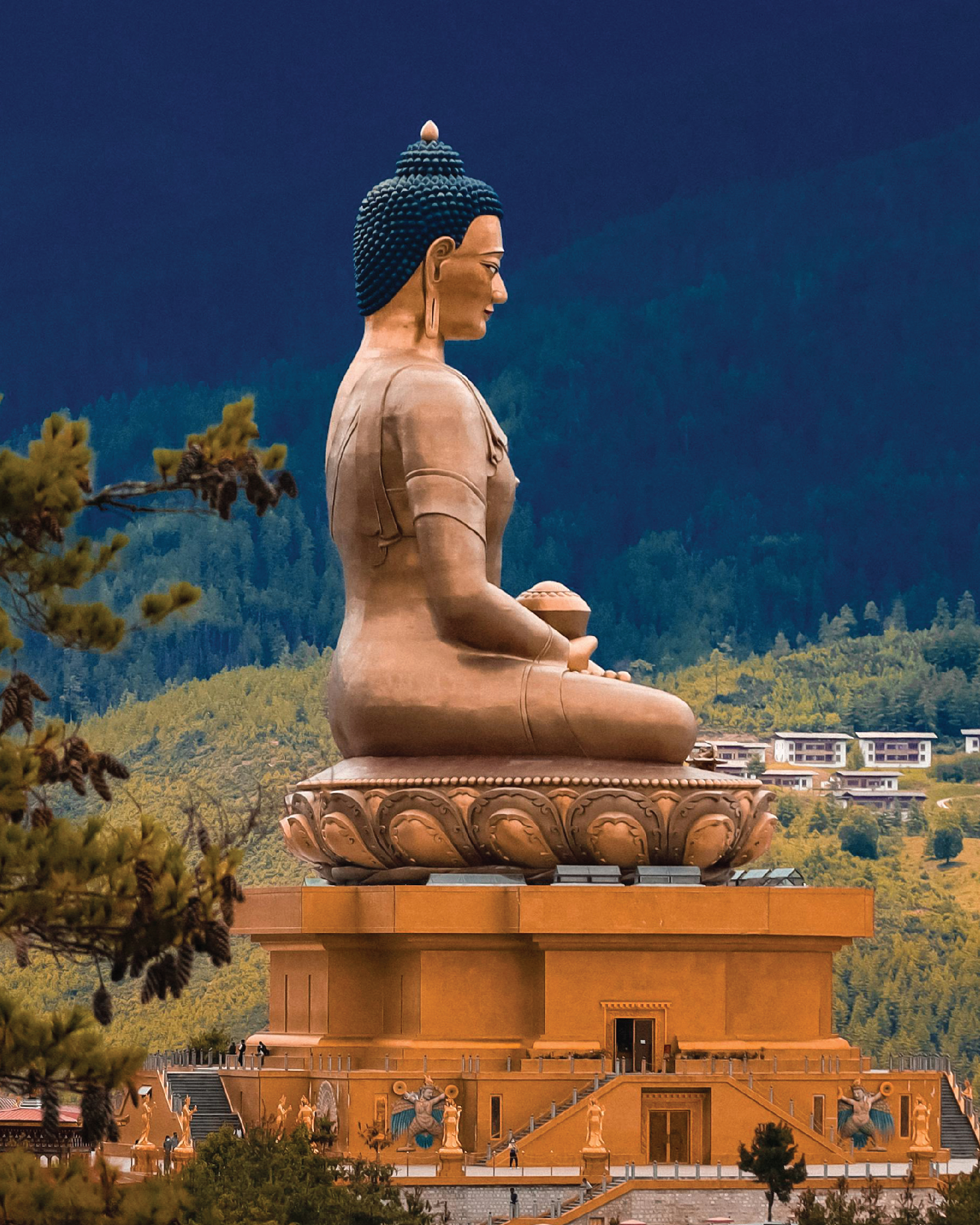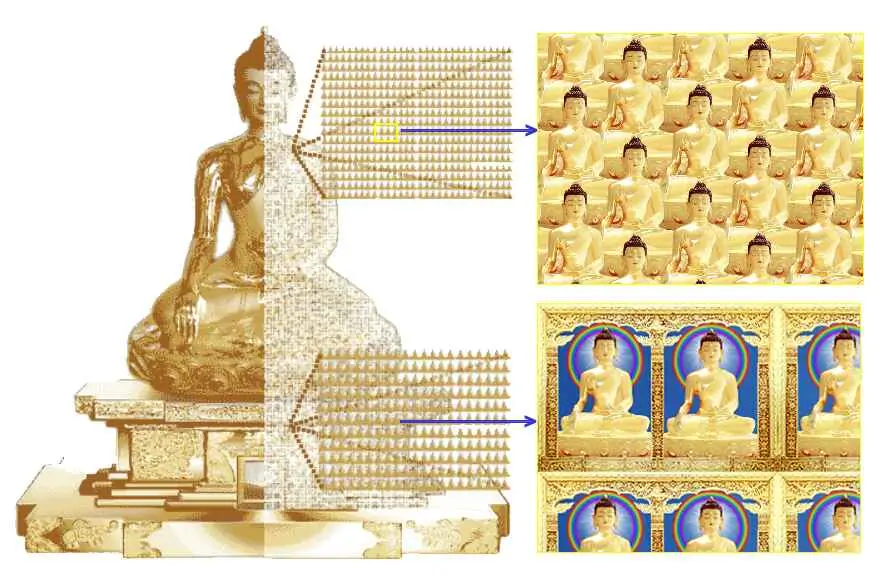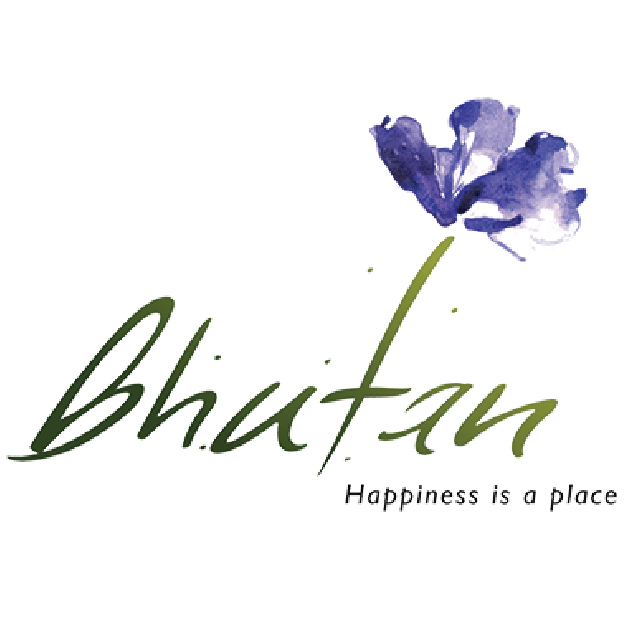TOP DESTINATIONS

Buddha Dordenma
If you are a tourist here in Bhutan, its probably wise not to ask a local or a Bhutanese about Buddha Dordenma or its location. You might either get a blank look or a direction to a different place. Locals call it Buddha Point. It is almost certain that more than 90% of the locals wouldn’t know if you call it Buddha Dordenma. So, Buddha Point it is, for us here in Bhutan.
The Buddha Dordenma (Shakyamuni Buddha) statue in Thimphu stands as one of the world's largest and tallest seated Buddha statues, reaching an impressive height of 169 feet (52 meters). Situated at an elevation of 2500m above sea level, it gazes over Thimphu, the capital city of Bhutan. This monumental statue is built on the remains of Kuensel Phodrang, once the palace of the 13th Druk Desi Sherab Wangchuk (1697-1767), which had fallen into disrepair and was essentially lost by the turn of the twenty-first century. Consequently, the construction of the statue didn't involve the demolition of any existing cultural heritage.
Fun Facts about Buddha Dordenma Statue
- Buddha Dordenma Statue is located at an elevation of 2500 m above sea level, in Thimphu – the capital city of Bhutan. It is located about 7-8 kilometers from Thimphu City.
- With 169 feet tall (52 Meters), It is one of the biggest & tallest Buddha Statue in the world.
- The statue’s sample was created with clay by the well-known Bhutanese Master Jenzop Lopen Sangay of Shaba, Paro, Bhutan.
- The construction was carried out by Aerosun Corporation of Nanjing, China, under the main sponsorship of Rinchen Peter Teo, a businessman from Singapore and about 20 other sponsors from various countries. Names of sponsors are displayed in the meditation hall which forms the throne of the Great Buddha Dordenma.
- The wisdom eye of the Buddha is made from diamonds worth 1 million US Dollars.
- The project costed over a 100 million US Dollars.
- The construction of the Statue began in 2006 and was planned to be completed in 2010, however, it was completed only on 25th September 2015.
- The construction of the Buddha Dordenma Statue is said to have fulfilled two prophecies.
- The consecration was overseen by Bhutan's highest religious authority, the Je Khenpo (Trulku Jigme Chhoeda) to commemorate the 60th Birth Anniversary of the fourth Druk Gyalpo Jigme Singye Wangchuck.
- The organizers of the Buddha Dordenma Project, formally transferred authority over the site to the Central Monastic Body of Bhutan on June 26, 2019.
- The Kuensel Phodrang nature park formally opened in 2011 dedicated to the Royal Wedding of His Majesty the fifth king Jigme Khesar Namgyel Wangchuck and Her Majesty the Queen Jetsun Pema Wangchuck, conserves 943.4 acres of forest area that surrounds the Buddha Dordenma statue and houses two public outdoor gymnasiums which opened in 2015.
The Prophecy of the Buddha Dordenma Statue – Killing two birds with one stone?
The construction of the Buddha Dordenma Statue is said to have fulfilled two prophecies. The first one dates back to the 8th century and is attributed to Guru Rinpoche (Guru Padmasambhava). It is believed that Terton Pema Lingpa (1450 – 1521), around 600 years ago in the 15th century, rediscovered ancient Terma (treasures) of Guru Rinpoche that mentioned the building of a statue in Bhutan to promote peace and happiness. The prophecy specifically mentioned, "A Shakyamuni statue would be built in the region between Wong and Paro, to bestow blessings of peace and harmony in the world."
In the twentieth century, Yogi Sonam Zangpo made another prophecy stating that a sizable statue of either Guru Rinpoche, Buddha, or a Phurba would be constructed in the region with the purpose of imparting blessings, peace, and happiness to the world.
Structure of the Buddha Dordenma Statue
The bronze statue consists of a mandala-shaped base standing at a height of 18.9 meters, topped by a 42.3-meter-high depiction of Buddha Shakyamuni. The Buddha is depicted in the Bhumisparsha Mudra, with the left palm facing upward and the right hand pointed downward toward the earth, symbolizing his summoning of the earth to bear witness to his enlightenment after overcoming the demon Mara.
Up to 100,000 8-inch-tall Buddha Dordenma statues occupy the massive Buddha's body and lotus, while approximately 25,000 12-inch-tall Buddha Dordenma statues are situated along the walls of the meditation hall. The positioning of the smaller Buddha statues can be observed in the accompanying image.

Encircling the site, a set of gold-plated dakini or apsara statues adorn the periphery, symbolizing the eight auspicious symbols that signify good fortune in Buddhist tradition. These graceful figures stand as eternal guardians, vigilantly watching over the mountaintop, their gaze fixed upon the Buddha in a tranquil display of victory.
In addition, there are magnificent carvings adorning the walls surrounding the meditation hall, featuring notable figures such as Zambala, the God of Wealth, and distinctive depictions of peacocks.
Furthermore, there is a small temple within the vicinity which contains a Buddha statue and a designated area for offering butter lamps. This five-story structure hosts various statues and mandalas on each level.
Ground Floor
The ground floor of the statue serves as the primary meditation hall and includes the following features:
- A 9-foot-tall Shakyamuni Buddha seated on a throne, accompanied by Assistant Sariputra and Assistant Mangalyana.
- Eighteen sitting Arahats, each standing at 5 feet tall, along with four directional kings.
- 12-inch-tall statues lining the walls.
- 34 major Mandalas and 33 Minor Mandalas adorning the ceilings.
- 72 minor golden dragon pillars.
First Floor
The central feature of the area is a 16-foot-tall four-faced sitting Vairochana Buddha, encircled by eight standing Bodhisattvas, each also measuring 16 feet in height. These Bodhisattvas include Avalokiteshvara, Manjushri, Vajrapani, Maitreya, Ksitigarbha, Akashagarbha, Sarvanivaranavishkambim, and Samantabhadra.
Additionally, there are 12-inch-tall Buddha Dordenma Statues positioned along the walls, while the ceilings are adorned with 28 major Mandalas. The space is supported by 8 major golden dragon pillars and 22 minor golden dragon pillars.
Second Floor
The central pillar is encircled by eight sitting Medicine Buddhas, each standing at 5 feet tall. These Medicine Buddhas include Tshenleng Medicine, Serzang, Drimed Nangwatai, Nyangenmed, Choedrag Gyatso, Ngoenkhen Gyalpo, Drayang Gyalpo, and Shakyamuni Buddha.
Furthermore, 12-inch-tall Buddha Dordenma Statues line the walls, while the ceilings feature 34 major Mandalas. Supporting the structure are 22 minor golden dragon pillars.
Third Floor
Below the area between the Buddha's right and left knees within the lotus, there are five chambers. These chambers are completely surrounded by 8-inch-tall Buddha Dordenma Statues. The interior of the massive Buddha is filled with these small Buddhas all the way up to the top. Additionally, there are five major Mandalas displayed on the ceilings.
First Chamber:The first chamber contains a presentation of sutras along with miniature 8-inch-tall Buddha Dordenma statues.
Second & Forth Chamber: The second and fourth chambers feature twelve depictions of Shakyamuni Buddha illustrating the twelve enlightening deeds:
- Descending from Tushita to the Human Realm
- Entering the mother's womb
- Taking birth
- Engaging in the arts, crafts, and sciences
- Marrying Princess Yashodhara and experiencing royal happiness
- Renouncing royal life to become an ascetic
- Enduring rigorous ascetic practices
- Making a vow to achieve enlightenment while seated under a Bodhi tree
- Overcoming demonic forces
- Attaining enlightenment beneath the Bodhi tree
- Teaching the Dharma
- Entering Parinirvana
Third Chamber: The third chamber features seven auspicious sitting Reunion Buddhas, each standing at 5 feet tall:
- Buddha Namparzig (Vipasyin/Vipassin)
- Buddha Tsugtorchen (Sikhin)
- Thamched Kyob (Visvabhu/Vessabhu)
- Buddha Khorwadesel (Krakucchanda)
- Buddha Serbub (Kanakamuni/Konagamana)
- Buddha Oedsung (Kasyapa/Kassapa)
- Buddha Shakyamuni
Additionally, the chamber contains representations of Wrathful Buddha Families:
- Guru Padmasambhava
- War Subdue Deity
- Cakrasambhava
- Vajrayogini
- Guru Dakmar
- Vajrakileya
- Pelchen Heruka
- Guru Dakpo
Fourth Chamber: The fifth chamber serves as a media room equipped with a 3D projector.
Fourth Floor
Encircling paintings depicting the 12 main life events of Buddha Shakyamuni are representations of the following peaceful Buddha Families:
- Samanthabadra
- Vairochana & Ingchuma
- Vajrasattva & Nyema Karmo
- Ratnasambhava & Mamaki
- Amitabha & Gyekarmo
- Amogasiddhi & Tara
- Red Lokeshvara Family - Galwa Jamtsho
- Vajradhara & Ingchuma
Photography is prohibited within the five-story halls located within the throne base, and access to the interior of the Shakyamuni statue is inaccessible. This arrangement effectively transforms the Buddha image into a living chorten, resembling a reliquary within a reliquary.
Best time to Visit Buddha Dordenma?
Visiting the Buddha Dordenma is ideal at any time, although we advise against visiting during rainy days. Morning visits offer refreshing air and picturesque views of the Capital City. Daytime visits provide ample sunlight for photography enthusiasts. Nighttime visits are equally enchanting, with the Buddha Dordenma illuminated by beautiful lighting.
Travel & Route Options to Buddha Dordenma
Visitors have multiple transportation options to reach the Buddha Dordenma from Thimphu City, which is approximately 7-8 kilometers away. They can drive directly or choose to bike or hike along the motor road. For those seeking a more scenic route through nature, there are two additional options.
The first option involves biking or hiking through the Buddha Point to Changangkha Biking Trail, which stretches about 5 kilometers. This route offers picturesque views and takes approximately 45 minutes by biking or 2 hours by hiking. Visitors can start from Changangkha Lhakhang, enjoy their time at Buddha Dordenma, and return via the motor road, or vice versa.
The second option is to bike or hike through the Depsi area, beginning just below the Buddha Dordenma and leading to Depsi through a nearby nunnery area. This trail spans approximately 3.5 kilometers.
Both routes showcase stunning scenery of Thimphu City and the surrounding natural landscapes, providing a refreshing experience with plenty of trees and fresh air. However, it's advisable to avoid biking or hiking during summer due to muddy trails caused by rainfall.




